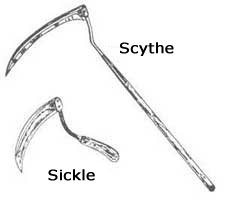7. The eye awake at right in Ga1-18 is greater than the pair in my gagana prototype:
In Ga1-18 the gap to the right of his 'throat' is wider than the corresponding gap at left (in the past), a sign which presumably indicates a higher sky roof in front. His powerful 'wing' in front is formed somewhat like the 'hook' of a toki, while his left 'wing' is formed like a tiny growing Moon crescent.
Saturn is the god who carries a scythe (or sickle), because he 'cuts' the old generation, determines when it is time to 'reap'. He is the god who 'creates time' by first terminating the old one and then igniting a new.
These 'hooks' are similar to the beak of a raven: ... In the morning of the world, there was nothing but water. The Loon was calling, and the old man who at that time bore the Raven's name, Nangkilstlas, asked her why. 'The gods are homeless', the Loon replied. 'I'll see to it', said the old man, without moving from the fire in his house on the floor of the sea. Then as the old man continued to lie by his fire, the Raven flew over the sea. The clouds broke. He flew upward, drove his beak into the sky and scrambled over the rim to the upper world ... The old man lying down at the bottom of the sea certainly represents Saturn. He owns the fire from which to ignite new years. The old man is like the planet Saturn not very eager to move. This Raven (Nangkilstlas) is Saturn. Saturn (like Sun and Moon and the rest of the celestial 'persons') appear in all 'habits of age', from the childish state at the eastern horizon and forward across the sky dome. When the clouds broke the Raven flew upward and drove his beak into the sky to get into the upper world. In other words his beak cut into the sky roof and divided it, he created a past and a future. His action is parallel to that of the Babylonian god of spring light, Marduk, who divided the night (Tiamat) in half. Next the Raven changed into a little baby: There he discovered a town, and in one of the houses a woman had just given birth. The Raven stole the skin and form of the newborn child. Then he began to cry for solid food, but he was offered only mother's milk. That night, he passed through the town stealing an eye from each inhabitant. Back in his foster parents' house, he roasted the eyes in the coals and ate them, laughing. Then he returned to his cradle, full and warm ... We can then jump to a later stage in the story: ... Hala qaattsi ttakkin-gha, a voice said: 'Come inside, my grandson.' Behind the fire, at the rear of the house, was an old man white as a gull. 'I have something to lend you', said the old man. 'I have something to tell you as well. Dii hau dang iiji: I am you.' Slender bluegreen things with wings were moving between the screens at the back of the house. Waa'asing dang iiji, said the old man again: 'That also is you.' When the white old man said 'I am you' it must be understood to mean that here Raven is encountering his old self - his grandfather - himself at a later stage in life. This is possible if we accept time travel, a necessary ingredient of myth. Then the old man continues to comment the 'slender bluegreen things with wings' who were moving between the screens at the back of the house, 'That also is you.' In other words, the slim young birds moving between the screens (divisions of the 'house') are also Ravens. As I remember it from Bringhursts explanations the feather cloaks of young ravens are not pitch black but bluegreen. Maybe the front 'wing' of gagana in Ga1-18 is meant to represent a sickle or the beak of a 'Raven'. I earlier once noted the resemblance between a beak and a 'crooked knife':
|




